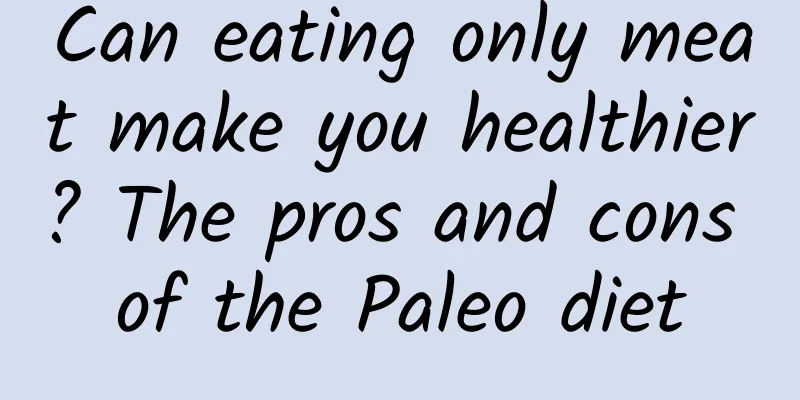Can eating only meat make you healthier? The pros and cons of the Paleo diet

|
The Paleo diet has become popular in recent years, with celebrities and internet influencers advocating a return to the way our ancestors ate, a diet centered around lots of meat and little carbohydrates. But did ancient humans really eat this way? This article explores the archaeological and nutritional evidence to reveal how the true Paleo diet differs from the modern popular version, and how the scientific evidence for this diet is complex and multifaceted. Written by | Xiaoye Paul Saladino is an American nutrition blogger with millions of followers. According to his personal website, he is a doctor of medicine who completed his residency at the University of Washington in Seattle and obtained the qualification of Physician Nutrition Specialist [1]. During his medical training, he was disappointed to find that the Western medical system only treated the symptoms but not the root cause. So, adhering to the belief that more people can live a healthy life through diet, he founded a personal social media platform and spared no effort to promote a diet based on meat and offal. In 2020, Saladino published the book The Carnivore Code, which found evidence from scientific literature that eating meat is good for the body, demonstrated the medical potential of a full-meat diet, and launched a matching meat recipe, which caused a sensation. Many Internet celebrities, Hollywood actors, athletes and even politicians have become supporters of meatism. A meat-based diet like the one recommended by Saladino can be collectively referred to as the “Paleo Diet,” which follows the diet of humans in the Paleolithic Age, while previous studies have suggested that primitive humans mainly ate meat. Their reason is simple: we evolved from the diet of our ancestors, and our genes have not had enough time to adapt to modern agricultural products. However, the diet that Saladino strongly advocates is one of the more extreme ones. For many years, he only ate offal and grass-fed beef, and abandoned all fruits and vegetables. He also claimed that this diet cured his asthma and severe eczema [2]. Saladino’s slogan is: “If you maintain the same diet as ancient humans millions of years ago, humans will continue to thrive!” But can the trending diets espoused by celebrities really make us healthier? Source: pixabay The real “Paleo diet” The "primitive diet" imitates the ancestors who lived in the Paleolithic era (about 2.6 million years ago or 2.5 million years ago to 12,000 years ago), but the question is, did they really eat meat? What did the ancient humans at that time eat? During the late Paleocene and early Miocene, primates such as humans, monkeys, and apes evolved a diet that was primarily based on fruit.[3] The Hominina lineage can be traced back to about 6 to 7 million years ago. Although known fossils show that they had learned to walk upright, they still spent a lot of time in trees and did not make any tools. Therefore, scientists speculate that their diet may be very similar to that of our closest living relatives, chimpanzees and bonobos, who are omnivorous animals and eat a lot of fruits, leaves, flowers, bark, etc.[4, 5] Around 3.5 million years ago, early hominid species such as Australopithecus afarensis and Kenyanthropus platyops began to expand their diets, eating animals in addition to plants. Archaeologists found cow and goat-sized mammal bone fragments at the Dikika site in the Afar region of Ethiopia, Africa, with traces of cutting and knocking. These were traces left by Australopithecus afarensis, the only hominid species living in the area at the time. This also shows that they had learned to use stone tools. This major discovery became the earliest key evidence that humans included meat in their diet [6, 7]. Evolutionary biologists believe that eating meat was crucial to our ancestors’ evolution of a larger brain. Meat and bone marrow, as high-calorie food resources, were different from the low-quality plant-based foods consumed by other apes, and could continuously provide more energy for our ancestors’ larger brains. Leslie Aiello, a professor of anthropology at University College London, and Peter Wheeler, a paleoanthropologist at Liverpool John Moores University, have proposed that the energy consumed by the human brain at rest accounts for 20% of the total energy consumed by the human body, while the ape brain only consumes 8% of the total energy, indicating that since the time of Homo erectus, our ancestors have relied heavily on high-energy foods, especially meat.[8] In addition, digesting high-calorie foods and reducing the intake of fibrous foods allowed humans to evolve a smaller intestine. Studies have shown that the energy released by the smaller intestine can be absorbed and utilized by the brain. In addition, animal food allowed primitive humans to become larger while still maintaining agile mobility and social attributes.[9] In addition, archaeological evidence also supports that humans have continued their meat-eating habits. Research by Briana Pobiner, a paleoanthropologist at the Smithsonian Institution’s National Museum of Natural History, and colleagues[10] shows that ancient humans began to eat large animals more frequently and continuously about 2 million years ago. The archaeological team discovered the “meat slaughterhouse” of early Homo sapiens at the southern site of Kanjera in southern Kenya. Our ancestors transported stones from more than ten kilometers away to here, made stone tools, and then slaughtered the animals they hunted or scavenged. The sedimentary layer that remains today is more than 3 meters thick, indicating that the history of animal slaughter has gone through many generations. In addition to terrestrial animals, archaeological excavations from Koobi Fora in Kenya show[11] that from about 1.95 million years ago, ancient humans included aquatic animals such as turtles, crocodiles and fish in their diet. Several archaeological sites in Olduvai Gorge in Tanzania can be traced back to 1.8 million years ago, and the mammals slaughtered there ranged from hedgehogs to elephants[12, 13]. As the saying goes: live by the mountain, eat by the mountain; live by the sea, eat by the sea. Homo erectus is considered a key node in the evolution of human diet, and its brain and body shape gradually evolved towards modern humans - many scholars believe that this is the credit of eating meat, that is, the meat-made-human hypothesis. The rapid increase in archaeological evidence of Homo erectus eating meat further confirms this view. Does this mean that ancient humans have evolved to this day with meat as their staple food? The answer is not certain. First, slaughterhouses like the Kandra ancients were not common. Moreover, analysis of the stone blade tools in the site found that a large number of wear marks were left by cutting plants and roots under the soil. Meat was not the only food for the local ancients. There is also a bias in scientific research methods. After analyzing evidence of human meat-eating in East African animal archaeological records between 2.6 million and 1.2 million years ago, W. Andrew Barr's team at George Washington University did not find a continuous increase in human meat-eating behavior, and the increase in archaeological evidence was simply the result of sampling bias - people paid more attention to archaeological discoveries of this period rather than human diet before that [14]. Jessica Thompson's team at Yale University believes that before humans invented tools suitable for hunting large animals, they may have used simple tools to extract nutritious bone marrow and brains from animal carcasses. Primitive people's target may be fat rather than meat (mainly lean meat on our tables today) [15]. For ancient humans, metabolizing lean meat from wild animals requires more energy, and in the absence of fat in the diet, it is easy to cause protein poisoning or other health problems. Although primitive people obtained animals through hunting or scavenging, they did not have meat for every meal. The Hadza and Kung people in Africa are the last modern groups that follow a hunting-gathering lifestyle. Even if they are fully armed today, they may return empty-handed more than half of the time, not to mention the primitive people who had no weapons and only simple tools more than 2 million years ago. Paleoanthropologist Alison Brooks joked: "The antelopes on the African grasslands don't stand there stupidly every day, waiting to be chopped up by humans one by one." So, when hunters get nothing, women and children gatherers provide more calories. The Zaha people in Africa can get nearly 70% of their calories from plants; the Kuhn people still rely on tuber food, mangoes, nuts, etc. from ancient times to the present; and the Aka and Baka Pygmies living in the Congo River Basin eat yams. In the Amazon region on the other side of the ocean, the Tsimane Indians and Yanomami Indians eat plantain and cassava; the recipes of Australian aborigines include cyperus and water chestnuts... The teeth of our ancestors also provide important clues to what ancient humans ate. The morphological characteristics of human teeth can tell us that our ancestors' diet was by no means limited to meat. Professor Lee Berger's team at the University of the Witwatersrand in Johannesburg, South Africa, analyzed the tooth wear patterns of two individuals of the species Australopithecus sediba and found tiny plant silica particles remaining on the teeth. Through carbon isotope analysis, the team learned that the food chewed by ancient humans at that time included bark, shrubs, leaves, and sedges [16]. A paper published in the journal Nature Ecology & Evolution in April 2024 conducted isotopic analysis of the tooth enamel of hunter-gatherers in North Africa during the Late Stone Age, proving that the main source of protein in their diet was plants rather than meat, thus challenging the view that pre-agricultural human groups were highly dependent on animal meat protein[17]. In other words, it was not entirely meat eating that made us human. Peter Ungar, a paleoanthropologist and evolutionary biologist at the University of Arkansas, explains that the teeth of Australopithecus were large and flat with a thick layer of enamel, indicating that they were adapted to chewing hard foods such as seeds and nuts, and their teeth played a grinding role. Homo sapiens evolved smaller teeth with a shape that was suitable for eating tough foods. However, we lack the sharp canine teeth that other carnivores need to pierce and tear prey, and we do not have carnassial teeth for cutting meat. Unger proposed that we are not pure carnivores, and our teeth did not evolve only for eating meat[15]. The Hadza people of Africa use berries as one of their foods. Image source: National Graphic The Bajau people of Malaysia rely almost entirely on fishing and diving for food. Image source: National Graphic Kyrgyz people in the Pamir Mountains in northern Afghanistan make a living by milking, slaughtering and trading livestock. Image source: National Graphic Daily meals for Cretan villagers: Mediterranean fish, snails and vegetables from the fields | Image source: National Graphic The modern “Paleo diet” This shows that the primitive diet discovered by archaeologists is not completely consistent with the "primitive meat-eating theory" widely marketed on modern social media. So how did the diet that is now highly praised by celebrities appear in the public eye? The concept of the “Paleo diet” was first proposed by American gastroenterologist Walter Voegtlin in the mid-1970s: people following a diet similar to that of the Paleolithic primitive people can significantly improve the health of modern people (mainly Westerners). Voegtlin published the book The Stone Age Diet, emphasizing that primitive people were meat eaters, mainly consuming animal protein and fat, as well as a small amount of carbohydrates. At the same time, based on Voegtlin’s personal treatment experience, it was found that people who followed this diet gained considerable health benefits. In 1988, a research team composed of doctors and anthropologists compared the living environment and diet of modern people with their prehistoric ancestors, and finally published the book The Paleolithic Prescription: A Program of Diet and Exercise and a Design for Living, pointing out that the nutritional intake ratio of the ancestors in the late Stone Age should be imitated, and the diet should not include foods that were not available before the emergence of agricultural civilization [18]. In 1989, Swedish doctor Staffan Lindeberg led a team to conduct the famous Kitava Study. Kitava is one of the islands in Papua New Guinea. The people living on the island mainly eat natural foods such as tubers, fruits, fish and coconuts, and maintain a life that is not affected by the eating habits of the modern industrial era. The results of the study showed that the locals not only have a low prevalence of cardiovascular disease, but also have almost no diseases common in Western society such as stroke and ischemic heart disease. The researchers believe that these are all related to the primitive diet [19]. This series of studies later became the scientific basis for doctors and nutritionists to promote the primitive diet. Since the 1990s, more doctors and nutritionists have been keen to call for a return to the so-called Paleolithic diet. In 2002, Loren Cordain, an American nutritionist and exercise physiologist, published the best-selling book "Paleo Diet", which became one of the mainstream healthy eating methods. The author emphasized the important health significance of unprocessed fresh ingredients such as lean meat, fish, vegetables, and nuts, while requiring strict restrictions on the intake of carbohydrates, grains, dairy products, sugar, and salt, especially processed foods produced by the modern food industry[20]. From 2010 to the early 2020s, the promotion of the Paleo diet became increasingly commercialized, and many celebrities endorsed it. According to statistics from the private website Ultimate Paleo Guide[21], NBA star LeBron James once challenged the Paleo diet for two months with his roommate during the off-season and achieved a certain weight loss effect, but his coach supervised him to resume a normal diet during the season[22]. In 2023, American actress Gwyneth Paltrow shared her eating habits in a podcast. After the COVID-19 pandemic, she was once troubled by COVID-19 inflammation. Subsequently, on the advice of her doctor, she adhered to the paleo diet for a long time and achieved good anti-inflammatory effects.[23] However, The Guardian published an opinion article, describing this behavior as strange and crazy.[24] Therefore, these cases are more like marketing that takes advantage of the celebrity effect.
What are the health benefits of the Paleo diet? So, are the short-term and long-term health effects of the Paleo diet really as beneficial as advertised, with no harm to the general public? First, if the goal is to lose weight, there is scientific evidence that the paleo diet has some effects. In 2020, a team from the University of Otago in New Zealand conducted a comparative study on 250 overweight people to evaluate the weight loss effects of the Paleo diet, intermittent fasting, and the Mediterranean diet[26]. The researchers found that in the short term of 6 months, the Paleo diet had a great advantage in weight loss because a low-carb diet in the short term can bring a higher sense of fullness, resulting in a faster weight loss effect[27]. However, after the 12-month weight loss trial, although the weight of the three groups of subjects decreased, the Paleo diet was the worst. On average, the Paleo diet subjects lost about 3.6 kg, the Mediterranean diet subjects lost 5.5 kg, and the intermittent fasting subjects lost about 8 kg. According to feedback from the subjects, the Mediterranean diet is the easiest to stick to among the three diets. In another earlier 2-year randomized trial[28], researchers tracked 70 overweight Swedish women, arranging one group of subjects to adhere to the Paleo diet for a long time, and the other group to follow the Nordic Nutrition Recommendations (NNR) to eat, which simply means consuming less protein and fat and more carbohydrates than the Paleo diet. After 6 months, the subjects who adopted the Paleo diet lost more weight than the NNR diet subjects. The former lost an average of 12 kg, while the latter only lost about 4.5 kg. But after 24 months, the final weight loss of the two groups was almost the same. In addition, the blood pressure and cholesterol levels of both groups were improved to a considerable extent. It is worth mentioning that the subjects who followed the Paleo diet had a greater reduction in triglyceride levels, and the level of this blood lipid is associated with the risk of heart disease. In the 2010s, when the Paleo diet was popular, a small study analyzed the possible relationship between the Paleo diet and cancer [29]. Colorectal cancer is the third most common cancer in the United States and is associated with Western dietary patterns. Researchers conducted a controlled analysis of patients with colorectal polyps and showed that strictly following both the Paleo diet and the Mediterranean diet can help reduce the risk of colorectal cancer. However, this study targeted a specific population, and the actual diet of the subjects may not be 100% consistent with the Paleo diet or the Mediterranean diet, so although it has a certain reference value, further in-depth investigation is still needed. Scientists are very concerned about the effects of long-term adherence to the Paleo diet. Professor Angela Genoni from Edith Cowan University in Australia led a cross-sectional study [30], which included a 44-person experimental group and a 48-person control group. The experimental group was required to adhere to the Paleo diet for more than one year and consume grains and dairy products no more than once a day, while the control group only needed to maintain a healthy and balanced diet. The results were quite surprising. Compared with the control group that adhered to a balanced diet, the Paleo diet subjects had unhealthy changes in their intestinal flora composition after one year: the abundance of Hungatella in the intestine increased, and higher levels of trimethylamine oxide (TMAO) were produced when digesting meat. TMAO has been shown to promote atherosclerosis and thrombosis at the molecular level, and is associated with the occurrence of cardiovascular disease. So, how should we eat? Source: pixabay Based on the existing research results, there are some reasonable points in the Paleo diet. For example, its emphasis on reducing or even avoiding the intake of industrial processed foods is consistent with the health concept that everyone pursues [processed meat products are classified as Class 1 carcinogens by the International Agency for Research on Cancer (IARC) under the World Health Organization]. However, everyone's physique, living environment and lifestyle are different, and there is no perfect and suitable diet for everyone. Therefore, if you blindly pursue the Paleo diet because of the celebrity effect, it may have a certain negative impact on your health in the long run. The best approach may be to avoid extremes and understand the pros and cons of each diet. The Paleo diet provides a dietary template, and after appropriate consultation with a nutrition expert, we can establish a dietary philosophy and model that best suits us. In addition, this year Saladino announced that for personal health reasons, he would abandon the strict primitive diet he followed, re-introduce carbohydrates and dairy products, and propose the so-called "animal diet", but the starting point remains the same: everything is for health. Special Tips 1. Go to the "Featured Column" at the bottom of the menu of the "Fanpu" WeChat public account to read a series of popular science articles on different topics. 2. Fanpu provides a function to search articles by month. Follow the official account and reply with the four-digit year + month, such as "1903", to get the article index for March 2019, and so on. Copyright statement: Personal forwarding is welcome. Any form of media or organization is not allowed to reprint or excerpt without authorization. For reprint authorization, please contact the backstage of the "Fanpu" WeChat public account. |
>>: If you often have trouble sleeping, will Alzheimer's disease come to you?
Recommend
How much do you know about Hawking's legendary story? Are his predictions and warnings reliable? (I)
Hawking's full name is Stephen William Hawkin...
Did Wang Feng make Xiaomi cry at the Meizu press conference on September 23?
On September 23, when you see Wang Feng singing o...
Analysis of Internet Marketing Routine Model
Nowadays, some network concepts emerge in an endl...
App promotion is at a bottleneck? 7 ways to solve your problems!
We all know the importance of App marketing . If ...
Can fish be infected with the new coronavirus? Why do we need to do nucleic acid testing?
Recently, fishing officially started in the water...
How does Haidilao improve its user retention rate?
The 2019 performance report of catering industry ...
How much does it cost to join a courier mini program in Qinhuangdao?
For entrepreneurs, although mini program developm...
Doctors urgently remind: Erythromycin ointment must not be used for a long time! Tell your family members immediately
Experts in this article: Wang Wei, Deputy Directo...
Waymo partners with car rental giant Avis to provide self-driving cars as a service
According to Reuters, Alphabet's self-driving...
A woman was hospitalized due to osteomyelitis after removing a hangnail from her finger. It turns out that a small hangnail can be so lethal!
Recently, Qilu Evening News reported that a woman...
Practical skills | How to build a sustainable online and offline operation system
Contents of this article: 1. Current situation &a...
Heavy rain is coming! You should know these self-help knowledge
Since April, most of southern China has experienc...
Collection level! Not only WeChat and Alipay, this article will show you all the mini program platforms
There are more and more platforms for mini progra...
Chris the Pickup Master "30 Day Plan" full version Baidu Cloud download
Introduction to the "30-Day Plan" by Ch...









